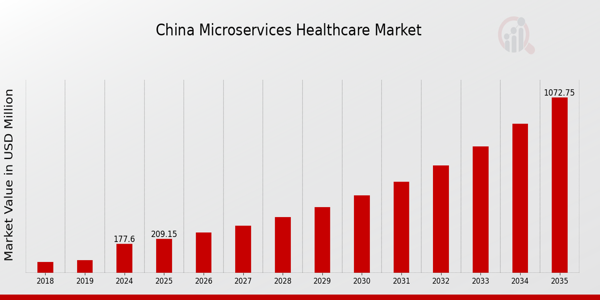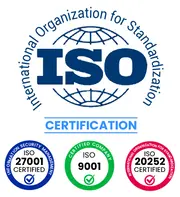China Microservices Healthcare Market Overview
As per MRFR analysis, the China Microservices Healthcare Market Size was estimated at 148.2 (USD Million) in 2023. The China Microservices Healthcare Market Industry is expected to grow from 177.6(USD Million) in 2024 to 1,072.8 (USD Million) by 2035. The China Microservices Healthcare Market CAGR (growth rate) is expected to be around 17.762% during the forecast period (2025 - 2035).
Key China Microservices Healthcare Market Trends Highlighted
The rapid digital transformation of the healthcare industry is driving significant trends in the China Microservices Healthcare Market. Healthcare providers are being compelled to implement microservices architecture in order to enhance patient care and operational efficiency. By utilizing this methodology, healthcare systems can be made more scalable and modular, which facilitates the integration of new technologies and simple updates.
In accordance with its objective to enhance healthcare delivery through technology, the Chinese government is actively promoting digital health initiatives. Consequently, there is an increasing investment in cloud-based services and applications that promote interoperability among a variety of healthcare systems. There are numerous opportunities in this market, particularly for technology providers that can provide customized solutions to address the unique challenges encountered by healthcare organizations in China.
The emphasis on real-time data analytics and patient-centered care creates opportunities for innovations that improve patient engagement and simplify workflows. Moreover, the development of specialized applications such as telemedicine platforms can be facilitated by the collaboration between healthcare institutions and technology companies. These applications are designed to enhance access to quality health services and extend care to rural populations.
Additionally, recent developments suggest that the healthcare sector in China is increasingly dependent on regulatory compliance and data security. Organizations are prioritizing the implementation of comprehensive security measures to safeguard patient information while complying with stringent data privacy regulations. This alignment with regulatory requirements influences the adoption of microservices, as these systems have the potential to improve the overall security architecture.
Furthermore, the integration of artificial intelligence and machine learning technologies into microservices is a significant step forward in the delivery of healthcare in China, as it enhances diagnostic capabilities and personalizes patient treatment pathways.

Source: Primary Research, Secondary Research, Market Research Future Database, and Analyst Review
China Microservices Healthcare Market Drivers
Increasing Adoption of Digital Health Technologies
The rapid digital transformation in China's healthcare sector is a significant driver for the China Microservices Healthcare Market Industry. The Chinese government has been heavily investing in digital health initiatives, with plans to increase the adoption of digital health technologies such as telemedicine and electronic health records.
According to the National Health Commission of China, there has been a reported 400% increase in telemedicine consultations since the COVID-19 pandemic, indicating a strong shift towards remote healthcare solutions. Furthermore, established organizations like Alibaba Health and Ping An Technology are leading the development of microservices in healthcare, enhancing patient care through innovative digital platforms.
The growing digital health landscape will facilitate more efficient healthcare delivery, consequently driving the demand for microservices healthcare solutions in China.
Rising Demand for Personalized Healthcare Solutions
There is a growing trend towards personalized healthcare, which is becoming a critical driver for the China Microservices Healthcare Market Industry. This shift is due to the increasing awareness among patients who prefer treatments tailored to their individual needs.
A recent survey by the China National Health Development Research Center revealed that 65% of patients expressed a preference for personalized treatment options, highlighting the burgeoning demand for such solutions.
Government Policies Supporting Healthcare Innovation
Government initiatives aimed at promoting healthcare innovation significantly propel the China Microservices Healthcare Market. The Chinese government has introduced policies such as the 'Healthy China 2030' initiative, which aims to improve health services and healthcare infrastructure nationwide.
The initiative outlines objectives to enhance healthcare access and quality, leading to a projected 30% increase in healthcare investments over the next decade. This is exemplified by the Ministry of Industry and Information Technology's focus on supporting innovative technologies in healthcare, which directly benefits organizations such as Sinopharm and China Medicine, propelling advances in microservices development within the healthcare sector.
Aging Population and Increased Healthcare Needs
The aging population in China is driving the demand for effective healthcare services, serving as a critical factor for growth in the China Microservices Healthcare Market Industry. By 2025, it is estimated that over 300 million individuals in China will be over the age of 60, significantly increasing the demand for healthcare services tailored to chronic and age-related conditions.
This demographic shift has prompted healthcare providers like New China Life Insurance to implement microservices to efficiently manage patient data and care solutions. The increasing number of elderly individuals presents not only challenges but also opportunities for the microservices healthcare market to grow through enhanced service delivery and patient management.
China Microservices Healthcare Market Segment Insights
Microservices Healthcare Market Application Insights
The Application segment of the China Microservices Healthcare Market plays a crucial role in transforming the healthcare landscape, driving innovation, and optimizing operational efficiencies through advanced technologies. This segment includes important areas such as Patient Management, Data Integration, Telemedicine, Revenue Cycle Management, and Health Information Exchange, each contributing uniquely to the overall market dynamics.
Patient Management systems enhance the experience for both patients and providers by streamlining appointment scheduling, tracking patient histories, and improving communication. Data Integration facilitates the seamless sharing of information across different healthcare systems, making it essential for creating a unified patient view and ensuring data accuracy for clinical decision-making.
Telemedicine has gained significant traction in China due to the increasing demand for accessible healthcare services, especially in remote areas. It enables virtual consultations, thereby expanding the reach of healthcare providers and improving service availability. Revenue Cycle Management is vital for maintaining economic sustainability in healthcare institutions by optimizing billing processes and ensuring financial compliance, crucial given the growing complexities of healthcare financing in China.
Health Information Exchange serves as a backbone for secure and efficient data sharing between healthcare entities, enhancing care coordination and patient outcomes. As the Chinese government invests in digital health initiatives and frameworks to support modern healthcare delivery, the Application segment is positioned to lead in further innovation, influenced by a rising focus on patient-centric care and the need for interoperability among healthcare systems.
Additionally, the rapid digital transformation in urban areas, coupled with a growing population and aging demographic, sets the stage for significant advancements and opportunities within this segment, ultimately aiming to meet the evolving healthcare needs of the Chinese populace. Overall, the Application segment of the China Microservices Healthcare Market is not only essential for enhancing operational efficiencies but also plays a pivotal role in improving health outcomes, further driven by technological advancements and a focus on patient-centric services.
Each area within this segment presents unique growth drivers, opportunities, and challenges, reflecting the broader changes occurring within the healthcare system in China.

Source: Primary Research, Secondary Research, Market Research Future Database, and Analyst Review
Microservices Healthcare Market Deployment Model Insights
The Deployment Model segment of the China Microservices Healthcare Market plays a critical role in shaping the landscape of healthcare IT solutions within the region. This segment is broadly categorized into Public Cloud, Private Cloud, and Hybrid Cloud. The Public Cloud is gaining traction due to its cost-effectiveness and scalability, allowing healthcare providers to leverage advanced analytics and storage capabilities efficiently.
In contrast, the Private Cloud is preferred for its enhanced security features, offering a secure environment for sensitive patient data, which is vital in a country with stringent data protection regulations. The Hybrid Cloud model facilitates a balanced approach, enabling healthcare organizations to benefit from both public and private cloud solutions, thus optimizing their operational efficiency while maintaining compliance with local standards.
As the healthcare sector in China increasingly embraces digital transformation, these Deployment Model approaches are essential for enhancing care delivery, improving patient outcomes, and fostering innovation within the industry. Notably, China's government support for digital healthcare initiatives further drives the adoption of these cloud solutions, making it a significant focus area for investment and development in the coming years.
Microservices Healthcare Market Service Type Insights
The China Microservices Healthcare Market, an evolving sector, is prominently characterized by its Service Type segmentation, which includes Application Development, API Management, Integration Services, and Consulting Services. Application Development has emerged as a crucial element for healthcare providers seeking to enhance patient experience and operational efficiency through tailored applications.
Meanwhile, API Management plays a pivotal role in ensuring seamless data exchange between various healthcare systems, crucial for integrating emerging tech and facilitating interoperability. Integration Services are significant as they unify disparate systems, leading to improved patient care, reduced errors, and enhanced data accessibility.
Consulting Services provide essential guidance for healthcare organizations in navigating the complexities of microservices architectures, focusing on optimizing technology investments and strategic planning. As healthcare in China increasingly adopts digital solutions, each of these service types becomes integral to not only advancing healthcare delivery but also responding to regulatory changes and patient demands.
The overall growth in this sector reflects a broader trend towards digital transformation in healthcare, driven by the need for efficient, flexible, and scalable solutions that address unique challenges faced by healthcare providers in China.
Microservices Healthcare Market End Use Insights
The China Microservices Healthcare Market is significantly shaped by its End Use segment, which includes various sectors such as Hospitals, Clinics, Insurance Companies, and Pharmaceutical Companies. Hospitals are often at the forefront, leveraging microservices to improve patient care through streamlined operations and enhanced data management.
Clinics, on the other hand, utilize these services to optimize patient interactions and administrative processes, striving for operational excellence in a competitive landscape. Insurance Companies benefit from microservices by improving claims processing and customer service, making insurance products more accessible to the public.
In the Pharmaceutical sector, microservices facilitate Research and Development, enabling quicker drug development cycles and regulatory compliance. Collectively, these sectors represent a robust opportunity for growth within the Microservices Healthcare Market, driven by increasing healthcare demands and technological advancements.
The focus on integrated healthcare solutions in China supports further expansion and adaptation of microservices, as stakeholders aim for more efficient and responsive systems that prioritize patient outcomes. Understanding the individual dynamics of these areas allows for a comprehensive view of the market landscape, ultimately contributing to enhanced healthcare delivery in China.
China Microservices Healthcare Market Key Players and Competitive Insights
The competitive landscape of the China Microservices Healthcare Market depicts a rapidly evolving sector driven by technological advancements and an increasing emphasis on healthcare efficiency and personalization. As healthcare providers seek innovative solutions to meet rising patient expectations and regulatory demands, microservices architecture has emerged as a crucial approach.
This shift allows for greater flexibility, scalability, and rapid deployment of healthcare applications, facilitating improved patient outcomes and operational effectiveness. Key players within this market strive to enhance their product offerings and differentiate themselves from competitors, focusing on attributes such as interoperability, security, and integration capabilities.
The competitive dynamics are shaped by factors including investment in research and development, strategic alliances, and the ability to adapt to an ever-changing regulatory landscape, positioning these companies to capture a larger market share in the burgeoning healthcare ecosystem of China. MediTrust has established a strong foothold in the China Microservices Healthcare Market, leveraging its advanced technology and innovative service delivery models.
The company is well-regarded for its robust microservices platform, which facilitates streamlined operations and real-time access to critical healthcare data. MediTrust is recognized for its strengths in providing tailored solutions to healthcare providers, helping them improve care delivery while reducing operational costs.
The company's emphasis on integrating artificial intelligence and data analytics into its offerings enhances patient management workflows and engagement. This focus on creating customer-centric solutions allows MediTrust to establish long-lasting relationships with clients and build a reputation as a trusted partner in the healthcare sector.
Qieyun, on the other hand, has also made significant strides in the China Microservices Healthcare Market, driven by its comprehensive range of healthcare technology solutions. The company specializes in offering cloud-based microservices that support various healthcare applications, including telemedicine and patient progress tracking systems.
Qieyun’s strength lies in its ability to provide flexible, scalable solutions that can easily integrate into existing healthcare infrastructures. The company has pursued strategic partnerships and collaborations to enhance its service offerings, which have contributed to an increased market presence. Additionally, Qieyun has undergone mergers and acquisitions to bolster its technological capabilities and expand its client base, positioning itself effectively within the healthcare technology landscape of China.
Through continuous innovation and a focus on customer needs, Qieyun remains a competitive player in the market, enhancing healthcare delivery across the nation.
Key Companies in the China Microservices Healthcare Market Include
- MediTrust
- Qieyun
- Yiwang
- Ping An Good Doctor
- JD Health
- iCare
- Alibaba Health
- Haodaifu Online
- We Doctor
- Zhongchao
- Tencent Healthcare
- China National Pharmaceutical Group
- DXY
- Guahao
- Yaozhi
China Microservices Healthcare Market Industry Developments
The China Microservices Healthcare Market has seen significant activity recently, particularly with companies like MediTrust, Ping An Good Doctor, JD Health, and Alibaba Health at the forefront of innovation and expansion. In October 2023, JD Health announced a strategic partnership with Alibaba Health to enhance its digital healthcare offerings, focusing on improving patient experience through improved microservices architecture.
In September 2023, Ping An Good Doctor launched a new AI-driven platform aimed at streamlining telemedicine services, showcasing the growing integration of technology in healthcare service delivery. Moreover, there have been notable mergers and acquisitions; for instance, in August 2023, Tencent Healthcare acquired a minority stake in Haodaifu Online, enhancing its service portfolio in online healthcare consultation.
Financial growth in this sector is highlighted by a reported valuation increase of over 25% in the past year among leading companies, driven by the rising demand for digital healthcare solutions, especially post-pandemic. Recent reports (2021-2023) indicated significant changes in regulations aimed at encouraging innovation within the healthcare space, reflecting the government's commitment to improving healthcare access and quality through technology.
China Microservices Healthcare Market Segmentation Insights
Microservices Healthcare Market Application Outlook
- Patient Management
- Data Integration
- Telemedicine
- Revenue Cycle Management
- Health Information Exchange
Microservices Healthcare Market Deployment Model Outlook
- Public Cloud
- Private Cloud
- Hybrid Cloud
Microservices Healthcare Market Service Type Outlook
- Application Development
- API Management
- Integration Services
- Consulting Services
Microservices Healthcare Market End Use Outlook
- Hospitals
- Clinics
- Insurance Companies
- Pharmaceutical Companies
| Report Attribute/Metric Source: |
Details |
| MARKET SIZE 2018 |
148.2(USD Million) |
| MARKET SIZE 2024 |
177.6(USD Million) |
| MARKET SIZE 2035 |
1072.8(USD Million) |
| COMPOUND ANNUAL GROWTH RATE (CAGR) |
17.762% (2025 - 2035) |
| REPORT COVERAGE |
Revenue Forecast, Competitive Landscape, Growth Factors, and Trends |
| BASE YEAR |
2024 |
| MARKET FORECAST PERIOD |
2025 - 2035 |
| HISTORICAL DATA |
2019 - 2024 |
| MARKET FORECAST UNITS |
USD Million |
| KEY COMPANIES PROFILED |
MediTrust, Qieyun, Yiwang, Ping An Good Doctor, JD Health, iCare, Alibaba Health, Haodaifu Online, We Doctor, Zhongchao, Tencent Healthcare, China National Pharmaceutical Group, DXY, Guahao, Yaozhi |
| SEGMENTS COVERED |
Application, Deployment Model, Service Type, End Use |
| KEY MARKET OPPORTUNITIES |
Cloud-based healthcare solutions, Interoperability and data integration, Enhanced patient experience platforms, Telemedicine and remote monitoring, Scalable healthcare application development |
| KEY MARKET DYNAMICS |
growing demand for digital health, increasing healthcare investments, government support for innovation, rising patient data management needs, focus on interoperability and integration |
| COUNTRIES COVERED |
China |
Frequently Asked Questions (FAQ):
By 2035, the China Microservices Healthcare Market is expected to reach a valuation of 1072.8 million USD.
The expected CAGR for the China Microservices Healthcare Market from 2025 to 2035 is 17.762%.
The Patient Management application is valued at 50.0 million USD in 2024.
Key applications driving the market include Patient Management, Data Integration, Telemedicine, Revenue Cycle Management, and Health Information Exchange.
By 2035, the Patient Management application is expected to have the highest market valuation of 300.0 million USD.
Major players in the market include MediTrust, Qieyun, Yiwang, Ping An Good Doctor, JD Health, iCare, Alibaba Health, and others.
The revenue projection for the Telemedicine application is estimated to reach 175.0 million USD by 2035.
The Data Integration application is expected to be valued at 210.0 million USD in 2035.
The Health Information Exchange is forecasted to reach a value of 147.8 million USD by 2035.
Challenges such as regulatory compliance and cybersecurity are expected to impact market growth in the coming years.
















